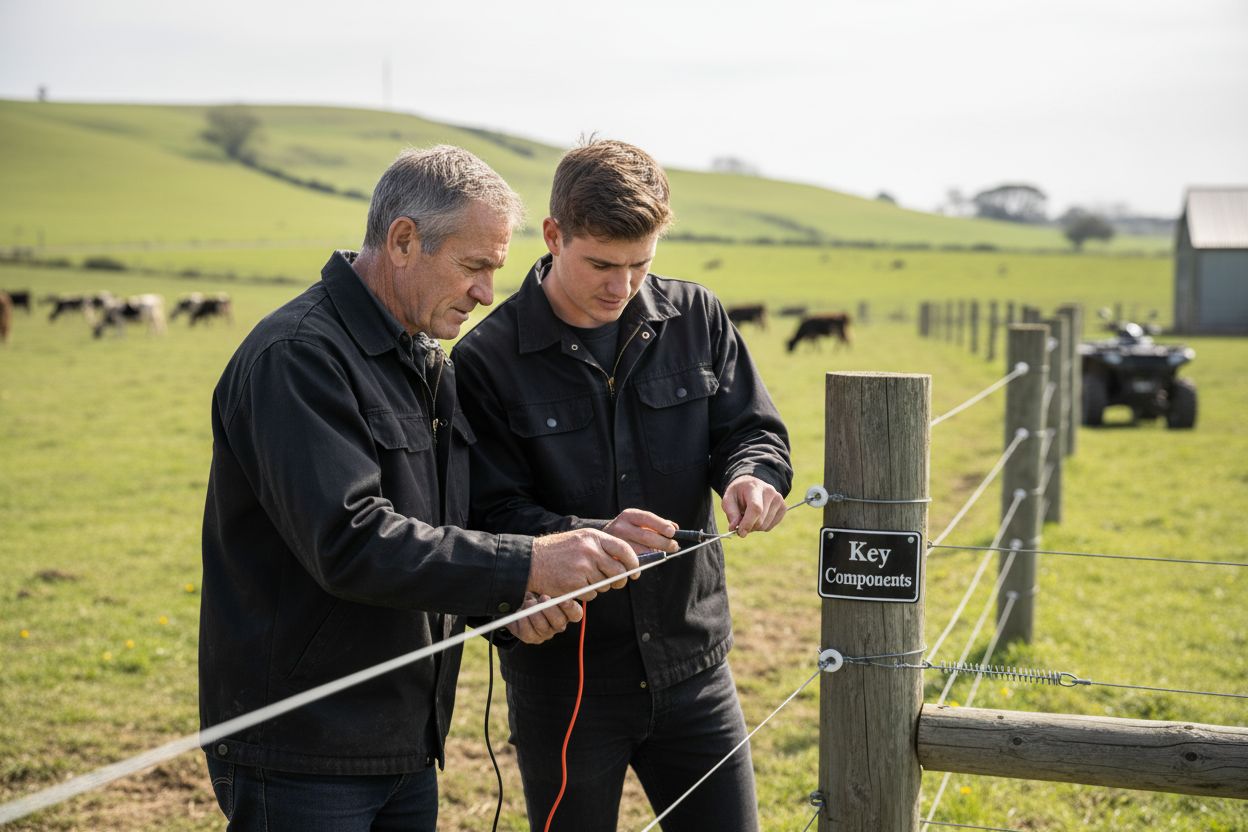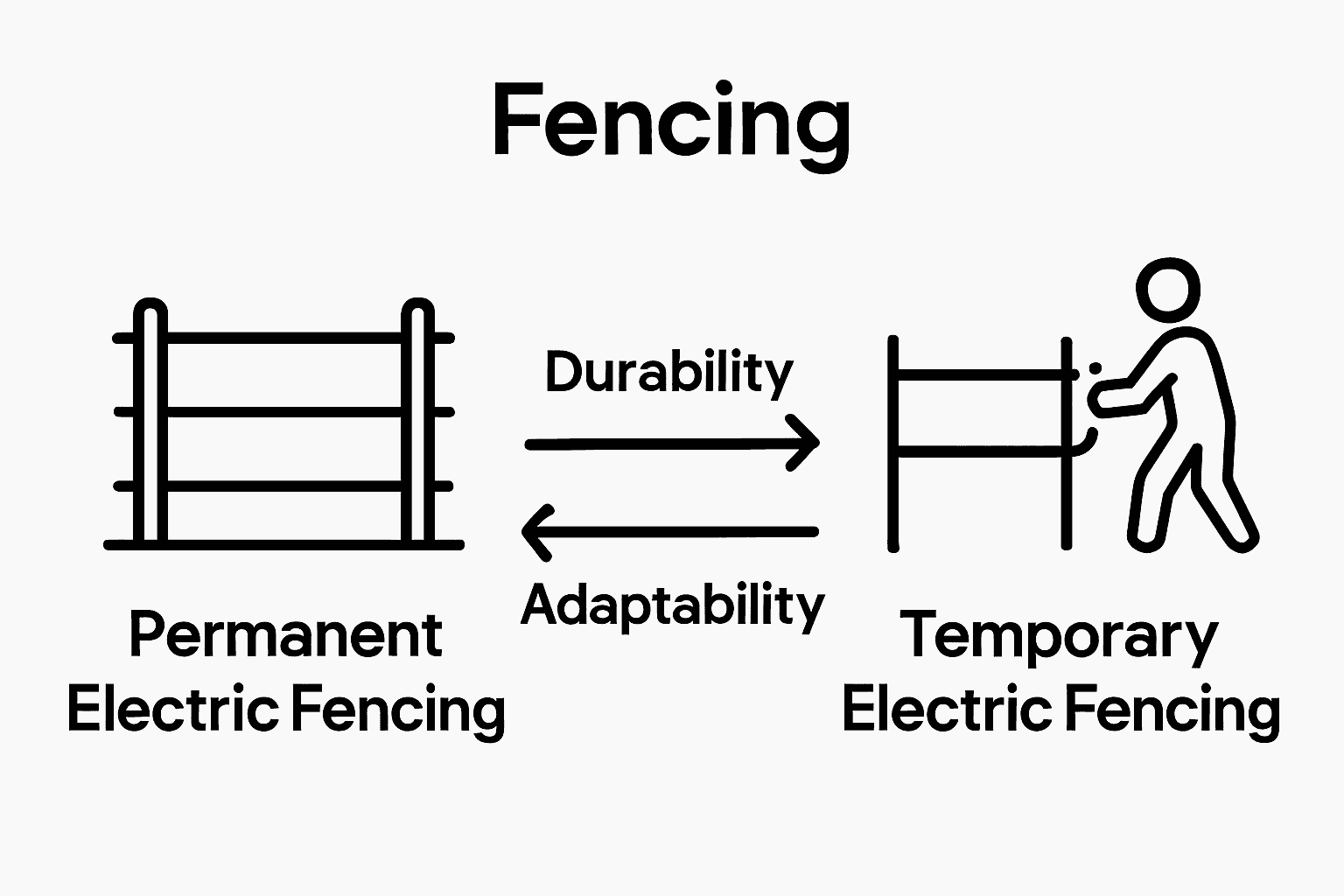Electric fences are popping up on farms and rural properties everywhere because they promise both security and smart animal control. Most people expect these systems to hurt or be unreliable in rough weather. But the truth is, a properly installed electric fence can cut installation and maintenance costs by up to 40 percent compared to traditional fencing and is designed to deliver a momentary shock that deters, not injures. With these facts, it is clear electric fences have changed the game for property management in more ways than one.
Table of Contents
- What Is An Electric Fence And How Does It Work?
- Why Electric Fences Matter For Livestock And Property Management
- Key Components Of Electric Fencing Systems
- Different Types Of Electric Fences And Their Uses
- Common Misconceptions And Facts About Electric Fences
Quick Summary
| Takeaway | Explanation |
|---|---|
| Electric fences deter animals effectively | They deliver a brief shock that trains animals to avoid the area without lasting harm. |
| Cost savings over traditional fencing | Electric fences can reduce installation and maintenance costs by up to 40%, making them economical for farmers. |
| Flexible for various agricultural needs | Available as permanent or temporary solutions, they suit numerous property management strategies. |
| Safe and humane technology | Designed to cause temporary discomfort, these systems prioritize animal welfare while offering security. |
| Comprehensive property protection | Electric fences prevent wildlife intrusion, protect crops, and secure property boundaries effectively. |
What is an Electric Fence and How Does It Work?
An electric fence represents a sophisticated livestock management and property protection system that uses controlled electrical pulses to create an invisible barrier. Unlike traditional physical fencing, electric fences leverage electrical current to deter animals and intruders through a psychological and physical deterrent mechanism.
The Fundamental Electrical Principles
At its core, an electric fence operates on a simple but effective electrical circuit principle. The system consists of three primary components: an energizer (power source), conducting wire, and ground system. When an animal or object touches the electrified wire, it completes an electrical circuit that delivers a short, sharp shock.
The energizer converts standard electrical power or battery power into high voltage, low amperage pulses that travel through the fence wire. These pulses are designed to be uncomfortable but not fatal, creating a powerful psychological barrier that trains animals to avoid the fence. Learn more about advanced electric fence technologies for comprehensive livestock management.
Practical Applications and Safety Mechanisms
Electric fence systems offer versatile protection for various scenarios in rural and agricultural settings. Key applications include:
- Preventing livestock from wandering beyond designated areas
- Protecting crops and property from wildlife intrusion
- Creating secure boundaries around sensitive agricultural zones
- Managing grazing patterns for optimal pasture management
According to agricultural research from Utah State University, electric fences provide a more humane and cost-effective alternative to traditional fencing.
The system’s design ensures that the electrical pulse is momentary and creates a psychological deterrent rather than causing lasting harm to animals.
Understanding electric fence basics requires recognizing that the shock delivered is a brief, startling sensation designed to educate rather than injure. The electrical current passes through the animal quickly, creating an immediate and memorable experience that discourages future contact with the fence.
Why Electric Fences Matter for Livestock and Property Management
Electric fences have transformed agricultural and rural property management by offering a sophisticated solution that balances security, efficiency, and animal welfare. These innovative barriers provide farmers and property owners with a powerful tool to manage livestock, protect valuable assets, and maintain clear property boundaries.
Economic and Operational Benefits
Implementing electric fencing delivers substantial economic advantages for rural property owners. By creating precise containment zones, farmers can optimize land use, control grazing patterns, and reduce ongoing maintenance costs associated with traditional fencing. Explore essential fencing strategies for small farms to understand comprehensive property management techniques.
According to research from the Agricultural Research Service, electric fences can reduce fencing installation and maintenance expenses by up to 40% compared to conventional wooden or wire mesh alternatives. The long-term cost savings make electric fencing an attractive investment for agricultural operations of all sizes.
Comprehensive Property Protection Strategies
Electric fences serve multiple critical functions beyond simple animal containment:
- Preventing wildlife intrusion and crop damage
- Creating secure perimeters around sensitive agricultural zones
- Protecting livestock from predators
- Establishing clear property boundaries without visual obstruction
- Minimizing the need for constant physical monitoring
The psychological deterrent provided by electric fencing goes beyond physical barriers. Animals quickly learn to respect these boundaries, reducing the likelihood of escape or unauthorized entry. This intelligent barrier system not only protects property but also promotes safer, more controlled agricultural environments.
By integrating electric fencing, rural property managers can achieve a sophisticated approach to land management that balances technological innovation with practical agricultural needs. The system offers unparalleled flexibility, allowing property owners to adapt their containment strategies to changing operational requirements while maintaining optimal safety and efficiency.
Key Components of Electric Fencing Systems
Electric fence systems are sophisticated networks of interconnected components that work together to create an effective barrier. Understanding these critical elements is essential for successful implementation and maintenance of a reliable electric fencing solution for agricultural and rural property management.
Essential Electrical Components
The heart of any electric fence system is its core electrical infrastructure. Three primary components form the foundation of an effective electric fence: the energizer, conducting wires, and grounding system. Explore our comprehensive troubleshooting guide for electric fence systems to understand potential technical challenges and solutions.
According to research from the University of Nebraska-Lincoln, each component plays a crucial role in the fence’s overall performance. The energizer converts electrical power into high-voltage pulses, the conducting wires distribute these pulses, and the grounding system ensures efficient electrical circuit completion.
Critical System Components and Their Functions
A comprehensive electric fence system includes several key elements beyond the basic electrical infrastructure:
- Energizer/Charger: The power source that generates electrical pulses
- Conducting Wires: Typically steel or aluminum wires that transmit electrical current
- Insulators: Prevent electrical current from escaping into supporting structures
- Ground Rods: Facilitate proper electrical circuit completion
- Warning Signs: Indicate the presence of an electrified fence
- Voltage Tester: Allows monitoring of electrical system performance
The interconnectivity of these components determines the overall effectiveness of the electric fence. Proper selection, installation, and maintenance ensure a reliable barrier that provides both physical and psychological deterrence for livestock and wildlife.
By understanding the intricate relationship between these components, property managers can design electric fence systems that are not only effective but also adaptable to various agricultural and rural property management scenarios. The right combination of technology and strategic implementation transforms electric fencing from a simple barrier into a sophisticated property management tool.

Different Types of Electric Fences and Their Uses
Electric fences are not a one-size-fits-all solution but rather a diverse range of specialized systems designed to meet specific agricultural and property management needs. Understanding the various types of electric fences enables property owners to select the most appropriate barrier for their unique requirements.
Permanent vs Temporary Electric Fencing Systems
Two primary categories of electric fencing dominate agricultural and rural property management. Permanent electric fences are fixed installations typically used for long-term livestock containment and property boundaries. Explore our comprehensive guide on essential livestock fencing options to understand the full spectrum of fencing strategies.
According to research from the Agricultural Extension Service, temporary electric fences offer remarkable flexibility for rotational grazing, short-term containment, and seasonal property management.
 These portable systems can be quickly deployed and relocated, making them invaluable for dynamic agricultural operations.
These portable systems can be quickly deployed and relocated, making them invaluable for dynamic agricultural operations.
Below is a table comparing the key differences between permanent and temporary electric fencing systems, helping property owners determine which type suits their specific needs.
| Feature | Permanent Electric Fencing | Temporary Electric Fencing |
|---|---|---|
| Intended Use | Long-term, fixed installations | Short-term, movable applications |
| Typical Applications | Property boundaries, main livestock pastures | Rotational grazing, seasonal needs |
| Installation Complexity | Higher (requires more labor and materials) | Lower (quick setup and removal) |
| Flexibility | Low (not easily relocated) | High (can be redeployed as needed) |
| Durability | Built for longevity and robust use | Designed for portability and moderate use |
| Cost | Higher initial investment | Lower initial investment |
Specialized Electric Fence Classifications
Electric fences can be further categorized based on their specific design and application:
- Livestock Containment Fences: Designed to prevent animals from escaping designated areas
- Predator Prevention Fences: Engineered with higher voltage to deter wildlife and protect livestock
- Crop Protection Fences: Specialized barriers to prevent wildlife from damaging agricultural crops
- Perimeter Security Fences: Used for property boundary marking and unauthorized entry prevention
- Solar-Powered Electric Fences: Environmentally friendly options utilizing renewable energy sources
The technological sophistication of modern electric fencing goes beyond simple barrier creation. These systems represent intelligent property management tools that adapt to diverse environmental conditions and agricultural challenges. By selecting the appropriate electric fence type, property owners can achieve optimal security, animal management, and land use efficiency.
Common Misconceptions and Facts About Electric Fences
Electric fences are often misunderstood technologies that generate significant confusion among agricultural professionals and property owners. Separating myth from reality is crucial for understanding their true potential and implementing them effectively in rural property management.
Safety and Physiological Impact Myths
One of the most prevalent misconceptions surrounds the potential harm caused by electric fences. Contrary to popular belief, these systems are designed to be safe and humane. Explore our comprehensive electric fence safety guidelines to understand the nuanced approach to animal and human protection.
According to research from the Canadian Agricultural Safety Association, electric fences deliver a brief, startling pulse that causes momentary discomfort but does not cause lasting physical damage. The electrical current is specifically calibrated to create a psychological deterrent rather than inflict injury.
Debunking Common Electric Fence Misconceptions
Several persistent myths surrounding electric fences require careful examination:
-
Myth: Electric fences are dangerous for all animals and humans Fact: Properly installed fences are designed with safety mechanisms to prevent severe injury
-
Myth: Electric fences are expensive and difficult to maintain Fact: They offer long-term cost savings and require minimal ongoing maintenance compared to traditional fencing
-
Myth: Electric fences are only suitable for large agricultural operations Fact: They can be effectively used in small farms, residential properties, and diverse agricultural settings
-
Myth: Electric fences are unreliable during extreme weather conditions Fact: Modern systems are engineered to withstand various environmental challenges
Understanding these nuanced realities transforms electric fencing from a misunderstood technology to a sophisticated property management tool.
The following table clarifies common myths and facts about electric fences to help dispel misunderstandings and inform property owners.
| Myth | Fact |
|---|---|
| Electric fences are dangerous for all animals and humans | Properly installed fences include safety mechanisms to prevent severe injury |
| Electric fences are expensive and difficult to maintain | They offer long-term cost savings and require minimal ongoing maintenance |
| Electric fences are only suitable for large operations | They can be used on small farms, residential areas, and varied agricultural settings |
| Electric fences are unreliable during extreme weather | Modern systems are engineered to withstand various environmental challenges |
| By recognizing the scientific principles and safety considerations behind electric fences, property owners can make informed decisions that balance security, efficiency, and animal welfare. |
Take Control of Your Rural Property With Expert Electric Fencing Solutions
Are you struggling to keep livestock safe or protect your farmland from wildlife? This article highlights real challenges like unreliable boundaries, unpredictable animal behavior, and the rising need for efficient, humane fencing. You just learned how electric fence systems combine technology and psychology to provide cost savings and peace of mind. Now imagine those same benefits working for you. At FenceFast.ca, you will find tailored electric fencing kits, energizers, and professional-grade livestock accessories that are designed for Canadian rural environments. Our product catalog has everything you need for secure animal management, plus consulting and expert advice to help you set up an effective system from the ground up.

Do not wait for issues like escapes, crop damage, or wasted time to get worse. Visit FenceFast.ca today to order quality fencing gear and gain access to our expertise. Take the next step toward safer, simpler rural property management and see how our electric fencing solutions can transform your land.
Frequently Asked Questions
What is an electric fence and how does it work?
An electric fence is a livestock management and property protection system that uses controlled electrical pulses to create an invisible barrier. When an animal or object touches the electrified wire, it completes an electrical circuit that delivers a brief shock, deterring them from crossing the boundary.
What are the primary components of an electric fencing system?
The three primary components of an electric fencing system are the energizer (which generates electrical pulses), conducting wires (that transmit current), and a grounding system (that ensures the circuit is complete). Additional components may include insulators, warning signs, and voltage testers.
What are the benefits of using electric fences over traditional fencing?
Electric fences offer several benefits, including lower installation and maintenance costs, the ability to create precise containment areas for livestock, and a humane method of deterring animals without causing lasting harm.
How do electric fences impact animal behavior?
Electric fences create a psychological barrier that teaches animals to avoid the area. The brief, startling shock they receive upon contact generates a memorable experience that discourages future attempts to cross the fence.
